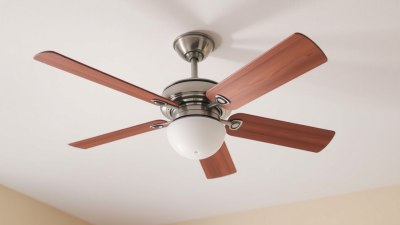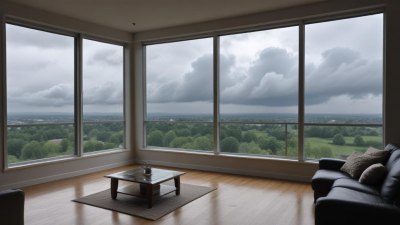How to Decode the Emotional Forecast of Your Ceiling Fan Settings
Explore how the settings of your ceiling fan can metaphorically represent and influence your emotional state, blending practical tips with insightful reflections.

Ceiling fans are more than just devices to circulate air or cool a room; they can also serve as unexpected symbols of our emotional states. Understanding how to decode the emotional forecast behind your ceiling fan settings offers a novel way of connecting with your feelings and creating a more mindful living space. This article will dive into how the direction, speed, and timing of your ceiling fan's operation can metaphorically reflect your inner world, offering subtle insights into your emotional climate.
At first glance, the notion that a ceiling fan’s settings could communicate or represent emotional signals might sound whimsical or abstract. However, given that home environments often mirror personal feelings, the way we interact with everyday objects can be revealing. The ceiling fan’s settings—such as speed, rotation direction, and duration—can be seen as an emotional forecast mechanism once you learn to interpret their subtle suggestions.
Understanding the Basics: What Your Ceiling Fan Settings Represent
Before diving into the emotional decoding, it's important to understand the technical aspects of ceiling fan settings. Most fans have multiple speed settings—low, medium, and high—as well as a directional switch that changes the rotation from clockwise to counterclockwise. Typically, the fan moves counterclockwise in summer mode to push cool air down and clockwise in winter mode to recirculate warm air.
Symbolically, these settings can be translated into emotional states. For example, a high-speed, counterclockwise rotation might symbolize high energy or a need for excitement and stimulation. Conversely, a slow, clockwise rotation may reflect a desire for calm, restoration, or introspection.
Fan Speed as a Mirror of Emotional Intensity
The setting you choose on your fan’s dial can correspond to the intensity of your current emotions. Running the fan at a high speed might indicate feelings of agitation, restlessness, or an energy surge that you need to release. A medium speed might suggest a balanced state where emotions are steady without extremes, while a low speed or even turning off the fan might point towards a need for quiet, relaxation, or subdued feelings.
For instance, if you notice you habitually set your fan to maximum when you're stressed or anxious, you might be unconsciously seeking a physical sensation that mimics your inner turmoil. Conversely, a fan set at a gentle breeze might be a subconscious attempt to create a soothing environment in moments of melancholy or weariness.
Decoding Fan Direction: The Emotional Winds Within
The fundamental function of the ceiling fan’s directional switch provides a meaningful metaphor for emotional orientation. In summer mode, the fan spins counterclockwise to produce a cooling breeze—a dynamic and outward movement representing extroversion, openness, and emotional ventilation. This can reflect an emotional state where you are actively engaging with the world, seeking refreshment and clarity.
On the other hand, the clockwise rotation is inward and gentler, creating an updraft that circulates warm air trapped at the ceiling. Emotionally, this suggests turning inward, introspection, and conserving energy. When your fan direction is set clockwise, it could signify a need to nurture yourself, focus on internal warmth and comfort, or to emotionally recharge.
The Duration Factor: How Long You Run Your Fan Speaks Volumes
Not only the speed and direction but also the length of time your fan is running can provide clues about your emotional landscape. Continuous operation for long periods might signal sustained emotions like anxiety, excitement, or even persistent worry. Short bursts of operation could suggest transient moods, moments of stress or inspiration that quickly ebb away.
If you find yourself frequently turning the fan off and on, this could reflect emotional volatility or ambivalence—mixed feelings or indecision. A fan that runs throughout the night might imply a restless mind or a desire to drown out other distractions to maintain emotional equilibrium.
Environmental Context and Personal Preferences
While decoding the emotional forecast from your fan settings is intriguing, it’s vital to consider environmental factors and personal comfort. Temperature, humidity, room size, and time of day influence your fan use as much as your feelings do. For instance, on hot days, setting the fan high is logical for cooling purposes but might also coincide with increased irritability or frustration, thus blending physical and emotional motives.
By becoming more conscious of how environmental comfort interacts with emotional preferences, you can begin to distinguish when your ceiling fan reflects actual physical needs versus purely emotional states. This awareness deepens your understanding of your responses to stress, relaxation, or changes in mood.
Practical Tips for Using Fan Settings as Emotional Signals
To use your ceiling fan settings as tools for emotional awareness, start by observing your choices and patterns. Keep a simple journal or mental note about which settings you favor during particular moods or situations. Are you drawn to slower speeds when feeling anxious? Does a clockwise direction help soothe sadness? Documenting these associations sharpens your emotional literacy.
You can also proactively use your fan to influence your emotional environment. For example, when feeling overwhelmed, deliberately switching to a slow, clockwise rotation can create a calming atmosphere, promoting relaxation. Conversely, when low energy affects your motivation, increasing fan speed and opting for a counterclockwise breeze might invigorate your mood.
Linking Fan Usage with Mindfulness Practices
Incorporating attention to your ceiling fan settings into mindfulness routines can amplify self-awareness and emotional regulation. During meditation or reflective pauses, note the fan’s operation—listen to its hum, feel the airflow, and consider any emotional shifts connected to its settings. This practice encourages present-moment awareness and links physical sensation with mental state.
Additionally, changing fan settings can be used as a ritualistic way to mark transitions in your day. For instance, setting the fan low and clockwise in the evening could signal the end of active time and the start of winding down. Recognizing these physical cues can help structure your emotional rhythm and foster balance.
Interpreting Changes Collaboratively in Shared Spaces
In homes where ceiling fans are shared among family or roommates, pay attention to how different users adjust the settings. Changes might not only reflect one person’s emotional state but influence the overall emotional climate of the space. Discussing these adjustments can open conversations about moods and emotional needs, enhancing communication and empathy.
For example, if a family member consistently changes the fan to a higher speed during stressful periods, others can recognize this as a signal and provide support. Conversely, intentionally altering settings to create a calm atmosphere might promote collective emotional wellbeing.
Emotional Symbolism in Other Fan Features
Advanced ceiling fans with features like adjustable lighting, remote controls, or programmable timers add further layers to the emotional forecast metaphor. Light intensity and color temperature changes can correlate with mood shifts or needs for emotional clarity or comfort.
Remote operation allows quick, sometimes subconscious adjustments that can serve as immediate emotional responses. Timer functions reflect planning and anticipation, possibly indicating a desire to control emotional environments proactively.
When is Fan Use More Than Symbolism?
While interpreting fan settings as emotional signals is insightful, remember that practical needs often take precedence. If your fan runs constantly because of a medical condition like heat intolerance or poor circulation, the emotional symbolism might be less relevant. Likewise, malfunctioning fans, noisy mechanisms, or poor placement could distort the emotional ‘forecast’ you're trying to interpret.
In such scenarios, focusing on the functional aspects and ensuring your living environment is comfortable physically will better support emotional regulation. Emotional decoding should augment, not replace, practical considerations.
The Ceiling Fan as a Metaphor for Life's Cycles
Beyond immediate emotional states, the cyclical nature of a ceiling fan’s rotation and its seasonal adjustments can symbolize the broader rhythms of life. The shift in direction for summer and winter reminds us of the necessity to adapt and balance opposing forces within ourselves—activity and rest, extroversion and introspection, heat and coolness.
Observing these cycles encourages acceptance of change and the impermanence of emotional states. Just as a fan changes direction and speed to meet seasonal demands, humans must adjust emotions and behaviors according to life’s ongoing fluctuations.
Integrating Fan Forecasts into Emotional Wellness Strategies
Incorporating awareness of your fan’s settings as part of an emotional wellness toolkit can strengthen self-regulation. Combine this insight with practices like journaling, breathing exercises, or therapy to deepen understanding of your emotional rhythms.
For example, use fan settings as a sensory anchor for grounding during overwhelming moments. Focus on the airflow, sound, and movement to reconnect with the present. Over time, these sensory connections can facilitate emotional resilience and calm.
Exploring Cultural and Personal Associations
Some cultures associate fans with symbolism of energy, fortune, or even spiritual messages. Personal histories with ceiling fans may also color emotional connections—memories from childhood rooms or significant moments shared in spaces cooled or warmed by fans add richness to the meaning they hold.
Exploring these associations can be a powerful tool in personal reflection, helping link emotional experiences with tangible objects in your environment, making feelings easier to recognize and process.
Storytelling Through Fan Settings: Crafting Your Emotional Narrative
Consider your fan settings as storytelling devices that express your internal narrative. Does the fan’s steady hum represent stability, or do frequent changes voice emotional turbulence? By framing these settings as chapters or themes in your emotional story, you can articulate and design your mood shifts with intention and awareness.
This creative approach transforms everyday actions into a form of personal expression. Instead of passive usage, your interaction with the fan becomes an active dialogue between your external environment and your internal world.
Potential Limitations of Decoding Emotional Forecasts
While this framework offers unique insights, it’s essential to recognize its subjective nature. Not everyone will find meaningful emotional analogies in fan settings, and emotions are complex and multifaceted. Avoid over-relying on this metaphor in isolation; it should complement, not substitute, other emotional awareness and wellness tools.
Moreover, avoid reading too much into coincidental fan use patterns. Emotions fluctuate naturally, and some usage habits stem from habit rather than feeling states. Balance sensitivity with pragmatism for best results.
Environmental Psychology and the Role of Objects in Emotion
Psychological research acknowledges that physical environments and objects significantly impact mood and behavior. The study of environmental psychology explains how sensory inputs such as temperature, lighting, and airflow shape emotional experiences. Ceiling fans contribute to this sensory mix and can thus be valid emotional cues.
By intentionally tuning these environmental elements, including fan use, individuals can craft spaces that support mental health and emotional wellbeing. This understanding is increasingly applied in architecture, interior design, and therapeutic practices.
Future Directions: Smart Fans and Emotional Intelligence
Advancements in technology have introduced smart ceiling fans that integrate with home automation systems and sensors. In the future, these devices might use biometric data or mood recognition algorithms to adjust settings automatically, optimizing emotional comfort.
This interplay between technology and emotional forecasting could lead to environments that actively support emotional wellness, reducing stress and enhancing relaxation by intuitively responding to user states. Until then, personal reflection and mindful interaction remain valuable tools.
Ultimately, the humble ceiling fan provides more than a breeze; through its settings, it offers a mirror reflecting our emotional landscape and a canvas to engage with our feelings more consciously and creatively.











